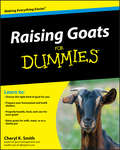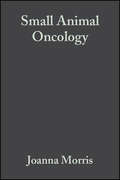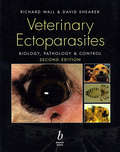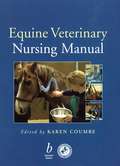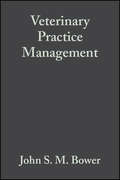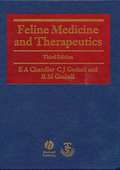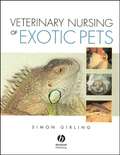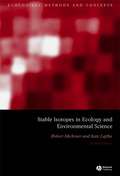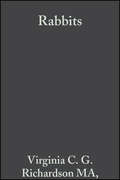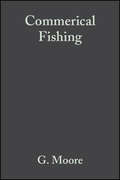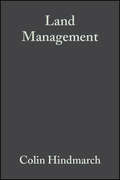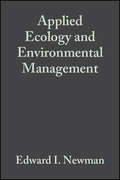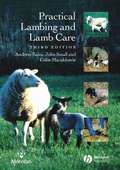- Table View
- List View
Raising Goats For Dummies
by Cheryl K. SmithRaise goats and reap the rewards. Raising Goats For Dummies provides you with an introduction to all aspects of owning, caring for, and the day-to-day benefits of raising goats. Raising Goats For Dummies is your How-to guide for: Breaking down the complicated process of choosing and purchasing the right goat breed to meet your needs and getting facilities for your goat set up. Providing in-depth information on proper grooming, handling, feeding, and milking Covering the basics of goat health and nutrition Offering tips and advice for using your goat to produce milk, meat, fiber, and more Understand what makes these useful and delightful creatures so popular and gain the knowledge and skills to properly care for and utilize their many offerings.
Raising Goats For Dummies
by Cheryl K. SmithRaise goats and reap the rewards. Raising Goats For Dummies provides you with an introduction to all aspects of owning, caring for, and the day-to-day benefits of raising goats. Raising Goats For Dummies is your How-to guide for: Breaking down the complicated process of choosing and purchasing the right goat breed to meet your needs and getting facilities for your goat set up. Providing in-depth information on proper grooming, handling, feeding, and milking Covering the basics of goat health and nutrition Offering tips and advice for using your goat to produce milk, meat, fiber, and more Understand what makes these useful and delightful creatures so popular and gain the knowledge and skills to properly care for and utilize their many offerings.
Handbook of Veterinary Nursing
by Hilary Orpet Perdi WelshHandbook of Veterinary Nursing provides the veterinary nurse with a quick reference point for many of the nursing procedures he or she may come across in the clinical setting. It provides clear and concise written instructions supported by diagrams and photographs which will be of benefit to veterinary nurses at all stages of their training and career. It will be particularly useful to those nurses studying for their RCVS Level Three Oral and Practical examinations. The book is laid out in note form and information is quick and easy to find with the use of bullets and tables. The emphasis is on the importance of working methodologically to a systematic routine using high quality procedures, thus helping the whole veterinary team ensure the most successful outcomes in animal care.
Small Animal Oncology
by Joanna Morris Jane DobsonNeoplasms are common in dogs and cats and it has been estimated that 50% of dogs and cats aged over 10 years die of neoplasia. The demand for treatment of pets with cancer is increasing and seems likely to do so for the foreseeable future as more animals become insured and their treatment costs are covered. The purpose of this book is to provide a basic clinical approach to the diagnosis and treatment of the more common tumours in dogs and cats for the practising veterinary surgeon, undergraduate student and veterinary nurse. It is not intended to be a comprehensive reference book, covering all aspects of veterinary oncology, since several such texts exist. Rather it seeks to provide a core of basic, easily accessible and clinically relevant information on general aspects of veterinary oncology. The first three chapters present general background information on pathogenesis, tumour biology, managing the cancer patient and the most frequently used methods of treatment. Practical details of chemotherapy and guidance on safety are given, as well as coverage of radiotherapy. The remaining chapters then provide specific information on the epidemiology, aetiology, pathology, presentation, staging, management and prognosis for tumours occurring in the different body systems.
Calculations for Veterinary Nurses
by Margaret C. Moore Norman G. PalmerThis handy pocket book will help veterinary nurses with all types of calculations. Numerous worked examples are included to develop the reader's confidence in carrying out the procedures involved. Each type of calculation has its own separate section in the book and the authors have used the simplest possible method in explaining each one. The book is structured in such a way that the reader can progress from a simple explanation of the arithmetic principles involved, to the application of these principles to essential veterinary calculations. Qualified veterinary nurses and students alike will find this book an invaluable reference source, whether performing relevant veterinary calculations or studying for professional examinations.
Veterinary Ectoparasites: Biology, Pathology and Control
by Richard L. Wall David ShearerEctoparasites are of growing significance in modern veterinary medicine and a detailed understanding of the biology of these parasites is fundamental to their appropriate treatment and control. The authors of this book have therefore provided a complete overview of the biology, and behaviour of arthropod ectoparasites along with the pathology and treatment of diseases in livestock and companion animals of temperate habitats. This is the only up-to-date book available written specifically for practitioners and students of veterinary medicine, animal husbandry and applied animal sciences. Such a unique volume is essential because in veterinary parasitology, ectoparasites such as the lice, mites, ticks, fleas or dipteran agents of myiasis assume far greater prominence than in other parasitological disciplines. Ectoparasite infestation of domestic and companion animals, therefore, has overt clinical features requiring a distinct approach to diagnosis and control. This book has been written with this in mind. The text takes a unique integrated approach combining both ectoparasite biology and veterinary dermatology. In the second edition of this successful book (previously, entitled Veterinary Parasitology), the detailed coverage of individual ectoparasite species has been expanded. Up-to-date information of new veterinary drugs and modes of application has been included and the practical clinical relevance of the information has been strengthened.
Equine Veterinary Nursing Manual
by Karen CoumbeEndorsed by the British Equine Veterinary Association, this book aims to cover the syllabus for the new RCVS equine veterinary nursing certificate. It covers subjects such as medical and surgical equine nursing, basic equine management and the theory underpinning these topics. It also includes chapters on nutrition, imaging and anatomy and physiology not previously well covered for the equine at a level appropriate for nurses. The approach is practical and the book is laid out in a user-friendly manner with copious illustrations.
The Physiological Basis of Veterinary Clinical Pharmacology
by J. Desmond BaggotThe diversity of species in which drugs are used for clinical purposes and the emphasis on various classes of drugs make veterinary pharmacology a complex subject. Anatomical and physiological features influence the pharmacokinetic behaviour of a drug in a particular animal and the dosage required. This book is concerned with the basis of species differences, the selection of pharmacokinetic parameters and the interpretation of values obtained. There are chapters on bioavailability and its application to veterinary dosage forms, changes in drug disposition and interspecies scaling, clinical selectivity and stereoisomerism, drug permeation, antimicrobial disposition and specifics related to neonatal animals. The author has gathered all this information together in one place so allowing the reader to make better selection of drug preparations for animal dosages to effectively treat animal diseases. The book will prove valuable to clinical researchers in the areas of pharmacology, anaesthesia, microbial infections and, internal medicine as well as postgraduate students of these disciplines. The Author J Desmond Baggot (MVM, PhD, DSc, FRCVS, DipECVPT) is currently Visiting Professor of Veterinary Pharmacology at the School of Veterinary Medicine, St George's University, Grenada, West Indies. He was a contributing author and co-author of Antimicrobial Therapy in Veterinary Medicine, 3rd Edition (2000) and Development and Formulation of Veterinary Dosage Forms, 2nd Edition (1998) and the author of Principles of Drug Disposition in Domestic Animals (1977). Elucidations of the processes that underline species variation in the disposition of drugs and interpretation of the influence of disease states on drug disposition have been the focus of his research endeavours. He was a member of the Editorial Board of the Journal of Veterinary Pharmacology and Therapeutics from 1978 to 1996. He is a former Professor of Clinical Pharmacology at the School of Veterinary Medicine, University of California, Davis and Preclinical Veterinary Studies at the University of Zimbabwe, Harare.
Veterinary Practice Management
by John S. Bower John N. Gripper Peter L. Gripper Dixon GunnThe third revised edition of this comprehensive book continues to provide an essential source of information on practice management. It gives straightforward guidance to veterinary surgeons setting up in practice for the first time as well as being invaluable to established practitioners and staff keen to improve the efficiency of their business. Those preparing for the Certificate in Veterinary Practice Management will find it particularly helpful. Written by recognised experts in their field, Veterinary Practice Management now includes new chapters on veterinary nurse clinics, pharmacy management, management accounts and staff appraisals. There is also new material providing information and advice on partnership contracts, business marketing and health and safety.
Feline Medicine and Therapeutics
by E. A. Chandler R. M. Gaskell C. J. GaskellKnowledge of the cat has advanced rapidly in the 9 years since the second edition of Feline Medicine and Therapeutics was published. The primary object of this book remains the same however - to help veterinary surgeons and students to practise the art and science of feline medicine.
Veterinary Nursing of Exotic Pets
by Simon J. GirlingFrom budgies and cockatiels to chipmunks and chinchillas, our interest in exotic pets has rocketed in recent years. With the house rabbit being the UK's third most commonly kept pet after the cat and dog, and sales in small mammals, reptiles and birds continuing to grow, exotic pets have now become a specialist area of veterinary practice in their own right. Veterinary Nursing of Exotic Pets is the first book to address the need for a definitive reference book devoted entirely to the principles and applications of nursing exotic species. Developed from a City and Guild's course, it not only covers husbandry, nutrition and handling, but also explores anatomy and chemical restraint, and provides an overview of diseases and treatments.
Handbook of Evidence-Based Veterinary Medicine
by Peter Cockcroft Mark HolmesThe application of evidence-based veterinary medicine (EBVM) can assist in improving and optimising the diagnosis, prognosis, control, treatment and ultimately the welfare of animals. It can also provide the user with a methodology for appropriate, patient orientated life-long, self-directed, learning. To practise evidence-based veterinary medicine we require a range of skills that we may not have. This book explains what evidence-based veterinary medicine is and shows how it can be applied to veterinary practice to improve the quality of care for patients and provide informed choices for owners. It provides the reader with a toolkit of skills necessary to practise evidence-based veterinary medicine. This book is aimed at practitioners but will be of interest to veterinary surgeons at any stage of their training or career wishing to learn about EBVM.
Diseases of Small Domestic Rodents
by Virginia C. RichardsonNot so long ago, hamsters, gerbils and mice were the only rodents kept as pets. Now the variety of rodents and the increasing popularity of these small creatures kept as pets has grown considerably. Since the last edition of Diseases of Small Domestic Rodents, two more rodents have been added to this book and become favourites among pet owners – the degu and the jird. As well as two new chapters on jirds and degus, this book has been fully revised and updated to reflect current developments in the treatment and knowledge of diseases in small rodents. With specific sections on anaesthesia and detailed information on drug treatments, Diseases of Small Domestic Rodents is the definitive reference book for students, breeders and practitioners alike.
Stable Isotopes in Ecology and Environmental Science
by Robert Michener Kate LajthaThis book highlights new and emerging uses of stable isotope analysis in a variety of ecological disciplines. While the use of natural abundance isotopes in ecological research is now relatively standard, new techniques and ways of interpreting patterns are developing rapidly. The second edition of this book provides a thorough, up-to-date examination of these methods of research. As part of the Ecological Methods and Concepts series which provides the latest information on experimental techniques in ecology, this book looks at a wide range of techniques that use natural abundance isotopes to: follow whole ecosystem element cycling understand processes of soil organic matter formation follow the movement of water in whole watersheds understand the effects of pollution in both terrestrial and aquatic environments study extreme systems such as hydrothermal vents follow migrating organisms In each case, the book explains the background to the methodology, looks at the underlying principles and assumptions, and outlines the potential limitations and pitfalls. Stable Isotopes in Ecology and Environmental Science is an ideal resource for both ecologists who are new to isotopic analysis, and more experienced isotope ecologists interested in innovative techniques and pioneering new uses.
Small Animal ECGs: An Introductory Guide
by Mike MartinThis book provides all the information that veterinarians need when using electrocardiography techniques for the first time. It is aimed squarely at the beginner, and is designed specifically for ease of use. It includes not only ECG tracings, but also clear and simple explanatory diagrams that accompany the text. Written by a Recognised Specialist in Veterinary Cardiology New chapters on the management and treatment of arrhythmias and on choosing an ECG recorder Suitable for all veterinary professionals, including practitioners, veterinary students, nurses and technicians
Essentials of Avian Medicine and Surgery
by Maria Krautwald-Junghanns Susan E. Orosz Thomas Tully Jr.Essentials of Avian Medicine and Surgery is designed as a concise quick reference for the busy practitioner and animal nurse. Eminently practical, this classic avian text is prized for its down-to-earth approach. new contributions from world renowned experts in avian medicine new chapter on the special senses of birds, an understanding of which is crucial when giving advice on avian welfare problems fully up-to-date on the latest diagnostic and imaging techniques avian zoonotics are highlighted in infectious diseases section
Managing and Designing Landscapes for Conservation: Moving from Perspectives to Principles
by David B. Lindenmayer Richard J. HobbsThe distinctive relationships between landscape change, habitat fragmentation, and biodiversity conservation are highlighted in this original and useful guide to the theory and practice of ecological landscape design. Using original, ecologically based landscape design principles, the text underscores current thinking in landscape management and conservation. It offers a blend of theoretical and practical information that is illustrated with case studies drawn from across the globe. Key insights by some of the world’s leading experts in landscape ecology and conservation biology make Managing and Designing Landscapes for Conservation an essential volume for anyone involved in landscape management, natural resource planning, or biodiversity conservation.
Diseases of Domestic Guinea Pigs
by Virginia C. RichardsonThis book provides a comprehensive text covering all aspects of guinea pig medicine. This updated edition will be of value to veterinary surgeons and students, veterinary nurses, breeders and all those working in the animal care industry. Written in note form the book assists in the formulation of a diagnostic plan when the practitioner is faced with a sick animal. Sections on clinical signs, diagnoses and treatments, allow rapid reference in successive chapters on the reproductive, digestive, respiratory, musculoskeletal and urinary systems, the skin, head and neck, nervous system and husbandry. All the latest drug information has been included and full details of dose rates, contraindications and components of the proprietary preparations are listed in chapter 11. A new chapter has been written providing information on herbal and homeopathic remedies.
Rabbits: Health, Husbandry and Diseases
by Virginia C. RichardsonRabbits are the third most popular pet in the world and the trend to keep them indoors will make the "house rabbit" the pet of the next century. Rabbit owners expect and deserve the same standard of veterinary care for their rabbits as they receive for their cats and dogs. Devoted entirely to the pet rabbit, this book is a practical and concise guide to health, husbandry and diseases. The book begins with an overview of rabbit husbandry. Nutritional requirements and clinical examination are covered in chapters 2 and 3. Subsequent chapters then take a body system approach to describing diseases, their diagnosis and treatment. There are separate chapters on behaviour, anaesthesia and surgery, and zoonotic aspects. This practical, quick-reference guide will appeal to veterinarians, veterinary students, veterinary nurses and breeders alike.
Making the Time: An Expert Guide to Cross Country Riding
by Stuart TinneyA crucial element of eventing is that horse and rider complete the cross-country course within a set time ('the optimum time'). If the competitor takes longer, significant penalty points are awarded against him or her. Many eventers try to achieve the optimum time by taking unnecessary risks, which, as Stuart Tinney explains, can be avoided if the correct training is carried out. Stuart Tinney, an Olympic gold medallist, completed the Sydney Olympic course easily within the optimum time, not through uncontrollable speed but through accurate and controlled riding. This skill and the associated training and horse management are explained and demonstrated in the book, including: Equipment for the horse and rider Walking the course Riding cross country safely and efficiently Training for cross country in the arena Horse fitness and management Horse types This book will therefore be of interest to all eventers from introductory to advanced level. Photograph of Stuart Tinney riding Calvin at Berrima by Max Wilson: agenda photography
Commerical Fishing: The Wider Ecological Impacts
by G. Moore Simon JenningsFishing provides food, income and employment for millions of people. However, fishing has environmental costs that threaten rare species, marine ecosystems and the sustainability of the resource. Based on the research expertise of leading scientists, Commercial Fishing: the Wider Ecological Impacts provides a lively, timely and accessible account of fishing activities and their impacts on marine habitats, biodiversity and species of conservation concern. It covers fishing methods that range from trawling in the Antarctic to fishing with dynamite in the tropics. The authors show how habitats such as the muddy sea beds of the deep sea, kelp forests and coral reefs are affected by fishing and how birds, mammals, turtles and sea snakes both suffer and benefit from fishing activities. They also look to the future, highlighting ways to make fishing gear 'environmentally friendly' and asking whether marine reserves will improve conservation.
Land Management: The Hidden Costs
by Colin Hindmarch Mike W. PienkowskiMature ecological criticism of agricultural policies is not easy: targets agreed in Biodiversity Action Plans must be achieved within a framework of agricultural and economic policies. Developing a balanced solution is the essence of sustainability. Until recently the hidden costs of high-production systems on biodiversity has been ignored. This booklet identifies some of the hidden costs of unsustainable production, and also considers examples where conservation management has failed. The authors argue that sustainable land management is possible, and that conservation and production interests can be satisfied. They go on to show how a sustainable approach can be applied throughout Europe. The approach adopted is the one that has underpinned the development of the European Union Biodiversity strategy and is becoming a compelling force for change in Europe's decision-making processes. Land managers and planners, ecologists and agriculturalists will, in particular, find this booklet an invaluable resource. However, it will also appeal to those with a more general interest in the issues of land management.
Behavioral Ecology of Insect Parasitoids: From Theoretical Approaches to Field Applications
by Eric Wajnberg Carlos Bernstein Jacques Van AlphenWritten by a team of leading international specialists, Behavioral Ecology of Insect Parasitoids examines the optimal behaviors that parasitoids exhibit in order to maximize long term offspring production. It is an essential reference for research scientists and students studying these fascinating insects or for anyone involved in using parasitoids in biological control programs. Reviews topical issues, including cutting edge research on parasitoid decision making and the implications for biological control Explores applications in other fields, provides information on the latest research methods, and includes helpful case studies and statistical tools Creates a deeper understanding of the link between behavioural strategies and host mortality, resulting in more efficient selective pest management programs “Overall, this is a fascinating volume that provides a significant contribution to the literature on parasitoid insects. It goes a long way toward providing insights into numerous aspects of parasitoid behavior and will stimulate a diversity of future projects, something that should be the goal of any such text. I highly recommend Wajnberg et al. for all of those working on the biology or evolution of parasitoids.” Palaios 2009
Applied Ecology and Environmental Management
by Edward I. NewmanThis book explains ways that ecological science can be applied to solving some of the most crucial problems facing our world today. A major theme is how resources can be effectively managed and exploited in as near a sustainable manner as possible. The author draws together, in a single volume, major topics in environmental and resource management that have traditionally been dispersed among several different books. Applied Ecology starts with an analysis of our planet's basic natural resources - energy, water and soil; it moves on to the management of biological resources - fish, grazing lands and forests, and then to pest control and pollution. Finally, the book tackles conservation and management of wild species and the restoration of ecological communities. The second edition of this text has been radically redesigned and rewritten. Each chapter starts with a list of questions, setting out the various fundamental problems to be considered. Interwoven with these practical problems is a clear explanation of the underlying basic science - ecology - studied at scales ranging from global, landscape and ecosystem, down to the population and individual (and even their physiology and genetics). The science is illustrated by examples from every major geographic area of the world. This book is aimed primarily at undergraduate students taking courses in applied ecology, environmental science, environmental management and natural resources management. The author has extensive experience as a university teacher. Like his lectures, this book is scientifically rigorous yet clear and easy to understand. Draws together major topics in environmental and resource management, usually dispersed over many separate books. Questions, summaries and clearly structured chapters enhance usability. Emphasis on clarity and accessibility. Based on a proven and successful course.
Practical Lambing and Lamb Care: A Veterinary Guide
by Andrew Eales John Small Colin MacaldowieMillions of lambs and ewes die each year during the lambing season. The reasons behind this high level of perinatal mortality are not easily explained and problems that do arise may be difficult to predict. This fully revised new edition of Practical Lambing and Lamb Care attempts to unravel this complex subject by providing practical guidance and information on all aspects of lambing and lamb care. It covers the major diseases and problems in lambs, from poisoning to foot and mouth disease, and includes chapters on the health of the ewe (including abortion issues), preventative methods, lambing techniques and also considers animal welfare issues. A first aid manual for all sheep farmers and veterinary students, with essential information on improving lamb mortality and avoiding stress at lambing time New material on zoonotic infections, handling and storage of drugs, flock health plans, and considerations for organic producers Lots of colour photographs to aid in the diagnosis, treatment and management of disease
